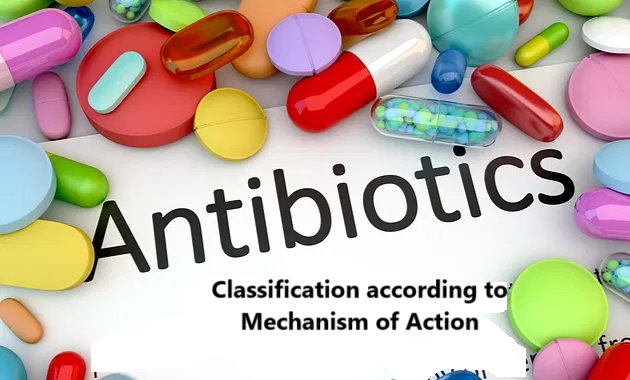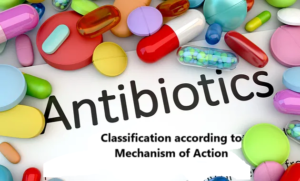What are Antibiotics? Antibiotic Classification According to Mechanism of Action
Antibiotics are substances that kill or inhibit the growth of bacteria. Antibiotics are a cornerstone of modern medicine that are used to treat bacterial infections. These drugs target specific parts of bacterial cells or processes and inhibit their growth or kill the bacteria. Antibiotics are classified according to their mechanism of action. This article will explore the antibiotics classification based on their mechanisms, along with examples for each.
Classification Based on Mechanism of Action
Inhibitors of Cell Wall Synthesis
Cell walls are an important part of bacteria to maintain their structure and integrity. Antibiotics that are inhibitors of cell wall synthesis in this category disturb or block the process of the synthesis of the bacterial cell wall leading to bacterial cell lysis or destruction its destruction.
Penicillins
- Mechanism
Penicillins inhibit the function of the enzyme transpeptidase, which is required for cross-linking the peptidoglycan layer of the bacterial cell wall.
- Examples
Penicillin G, Amoxicillin, Ampicillin.
- Use
Treats infections such as pneumonia, strep throat, and syphilis.
Cephalosporins
- Mechanism
Cephalosporins also inhibit bacterial cell wall synthesis by binding to penicillin-binding proteins (PBPs) like penicillins.
- Examples
Cefazolin, Ceftriaxone, Cefepime.
- Use
- It treats a broad range of infections including respiratory, urinary tract, and skin infections.
Carbapenems
- Mechanism
Carbapenems bind to PBPs and inhibit the synthesis of bacterial cell walls, similar to penicillins and cephalosporins but with broader-spectrum activity.
- Examples
Imipenem, Meropenem.
- Use
Effective against a wide variety of multi-drug-resistant bacteria.
Glycopeptides
- Mechanism
Glycopeptides bind to the D-alanine-D-alanine portion of the peptidoglycan precursor and prevent its incorporation into the bacterial cell wall.
- Examples
Vancomycin, Teicoplanin.
- Use
Used primarily against Gram-positive bacteria, especially in resistant infections like MRSA.
Inhibitors of Protein Synthesis
Protein synthesis is a critical process for bacterial growth and function. Antibiotics that target protein synthesis prevent bacteria from producing the proteins necessary for the survival and replication of bacteria.
Aminoglycosides
- Mechanism
Aminoglycosides bind to the 30S ribosomal subunit induce misreading of mRNA coding and inhibit protein synthesis.
- Examples
Gentamicin, Streptomycin, Tobramycin.
- Use
It is used to treat serious infections like pneumonia, tuberculosis, and sepsis.
Macrolides
- Mechanism
Macrolides bind to the 50S ribosomal subunit and inhibit the elongation of the polypeptide chain.
- Examples
Erythromycin, Azithromycin, Clarithromycin.
- Use
Drug of choice to treat respiratory infections, skin infections, and sexually transmitted diseases.
Tetracyclines
- Mechanism
Tetracyclines bind to the 30S ribosomal subunit and prevent the attachment of aminoacyl-tRNA to the ribosome.
- Examples
Doxycycline, Minocycline, Tetracycline.
- Use
It is used to treat acne, urinary tract infections, and respiratory infections.
Chloramphenicol
- Mechanism
It binds to the 50S ribosomal subunit and inhibits the formation of peptide bonds.
- Examples
Chloramphenicol.
- Use
It is drug of choice for severe infections, including meningitis and typhoid fever.
Clindamycin
- Mechanism
It binds to the 50S ribosomal subunit and prevents the elongation of the peptide chain.
- Examples
Clindamycin.
- Use
Treats infections like skin infections, osteomyelitis, and respiratory tract infections.
Inhibitors of Nucleic Acid Synthesis
Bacterial nucleic acids DNA and RNA are primary requirements for bacterial replication and function. These Antibiotics inhibit nucleic acid synthesis interfere with the replication process and make it impossible for bacteria to reproduce.
Fluoroquinolones
- Mechanism
Fluoroquinolones inhibit DNA gyrase and topoisomerase IV, which are necessary for bacterial DNA replication.
- Examples
Ciprofloxacin, Levofloxacin, Moxifloxacin.
- Use
Treats urinary tract infections, respiratory infections, and gastrointestinal infections.
Rifamycins
- Mechanism
Rifamycins bind to bacterial RNA polymerase and prevent the transcription of RNA.
- Examples
Rifampin, Rifabutin.
- Use
- Typically used for tuberculosis and some other bacterial infections.
Metronidazole
- Mechanism
It interferes with bacterial DNA by forming free radicals, leading to DNA strand breaks.
- Examples
Metronidazole.
- Use
It is Effective against anaerobic bacteria and is used to treat conditions like bacterial vaginosis and Clostridium difficile infections.
Inhibitors of Metabolic Pathways
Bacteria rely on specific metabolic pathways to survive. Antibiotics in this class disrupt bacterial metabolism. As a result it lead to the inhibition of bacterial growth.
Sulfonamides
- Mechanism
Sulfonamides inhibit dihydropteroate synthetase. It is an enzyme required for the synthesis of folic acid. Folic acid is critical compound for bacterial DNA and RNA synthesis.
- Examples
Sulfamethoxazole, Sulfadiazine.
- Use
Often used in combination with trimethoprim for treating urinary tract infections, respiratory infections, and some gastrointestinal infections.
Trimethoprim
- Mechanism
Trimethoprim inhibits dihydrofolate reductase. It is an enzyme necessary for converting dihydrofolate to tetrahydrofolate. Tetrahydrofolate is needed for bacterial DNA synthesis.
- Examples
Trimethoprim.
- Use
Commonly combined with sulfonamides (in TMP-SMX) for urinary tract infections and other bacterial infections.
Disruptors of Cell Membrane Integrity
These antibiotics affect the integrity of bacterial cell membranes, leading to leakage of cellular contents and bacterial death.
Polymyxins
- Mechanism
Polymyxins interact with the phospholipids of the bacterial cell membrane. It makes membrane disruption and leakage of essential cellular contents.
- Examples
Polymyxin B, Colistin.
- Use
Polymyxins are used for multidrug-resistant Gram-negative infections, including Pseudomonas aeruginosa and Acinetobacter species.
Daptomycin
- Mechanism
It binds to bacterial cell membranes, leading to depolarization and loss of membrane potential, ultimately causing cell death.
- Examples
Daptomycin.
- Use
Used to treat Gram-positive infections, including MRSA and vancomycin-resistant enterococci (VRE).
Conclusion
Thus, Antibiotics play a vital role in the treatment of bacterial infections. Their mechanisms of action are key to their effectiveness. They work by targeting and destroying the critical processes in bacterial cells, such as cell wall synthesis, protein synthesis, nucleic acid replication, metabolic pathways, and cell membrane integrity. The misuse of antibiotics can lead to antibiotic-resistant. Continued research and innovation are essential to combat resistance and ensure that antibiotics remain effective tools in the fight against bacterial infections.

